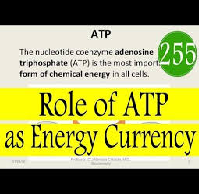ATP as the Energy Currency of the Cell Order Instructions: Please read below for information concerning assignment.

Support responses with examples and use APA formatting in the paper. You may access the school’s website by logging into:
https://mycampus.southuniversity.edu/portal/server.pt
Please note that when you log into the website you must click launch class, and on the next screen click syllabus to view this week’s readings (week 3) and Academic Resources to access the school’s library.
Please address each aspect of both questions thoroughly, leaving as little room as possible for the instructor to need to ask follow-up questions.
Respond to both of the discussion questions listed.
Question 1: ATP as the energy currency of the cell
ATP (adenosine triphosphate) has been called the energy currency of the cell. Briefly outline the cycle by which energy is stored in and released from ATP. Explain the importance of the phosphate bond to this series of processes. Be prepared to discuss how ATP is critically important to cellular chemical processes.
Question 2: Enzyme action and their importance to life
Enzymes are protein materials that serve to control chemical processes within the cell. Briefly describe how enzymes work and explain their importance to the chemical processes of living organisms. Pick a specific enzyme and describe its function and the importance of that function to life. Discuss how the loss of that enzyme would disrupt living processes? Be prepared to discuss the action and importance of the variety of enzymes used as examples in this discussion.
ATP as the Energy Currency of the Cell Sample Answer
Week 3 Assignment 1
ATP as the Energy Currency of the Cell
ATP (adenosine triphosphate) is a nucleotide composed of adenosine, a ribose, and a triphosphate. ATP is a molecule rich in energy because its triphosphate moiety contains two energy-rich phosphoanhydride bonds. A huge amount of energy is dissipated when ATP is broken down to ADP (adenosine diphosphate and Pi (orthophosphate) or when ATP is degraded to AMP (adenosine monophosphate) and PPi (pyrophosphate). The free energy released is used in energy requiring metabolic processes such as muscle contraction, biosynthetic pathways, and active transport. The energy derived from oxidation of food or from light is used to phosphorylate AMP and ADP to reform ATP.
Enzyme action and their Importance ATP as the Energy Currency of the Cell
Enzymes are biological catalysts that accelerate biochemical reactions and determine the patterns of transformations. Indeed, in the absence of enzymes, most biological reactions occur at perceptible rates. Most enzymes are proteins but there is evidence of catalytically active RNA molecules. Enzyme catalysis occurs at a specific site on an enzyme called active site. Enzymes act by bringing substrates together in an optimal orientation by using the full repertoire of intermolecular forces. They catalyze reactions by selectively stabilizing the highest-energy species in reaction pathways called transition states (Berg et al., 2012). An example of an enzyme is carbonic anhydrase, which catalyses the reversible conversion of carbon dioxide and water to form bicarbonate and protons. Carbonic anhydrase plays role in the transfer of carbon dioxide from the body tissues into the blood and then to the alveolar space for expulsion (Nelson&Cox, 2013). The interconversion of carbon dioxide and bicarbonate also maintains acid-base balance in the blood. The enzyme is a drug target for dichlorphenamide, acetazolamide, and methazolamide for the treatment of glaucoma. There are at least seven isozymes of carbonic anhydrase present in humans. The mechanism of action of carbonic anhydrase II, which is present in high concentrations in RBC has been extensively studied (Berg et al., 2012; Voet &Voet, 2011).
Mechanism of Action of Carbonic Anhydrase
Carbonic anhydrase catalyzes the hydration of carbon dioxide to form a proton and a bicarbonate ion. The enzyme contains a zinc ion as a prosthetic group in its active site and is thus a metaloenzyme. The zinc ion is held in position by imidazole rings of three histidine residues His 94, His 96, and His 119. Since zinc atom is always bound to four or more ligands, in carbonic anhydrase, a water molecule or a hydroxide ion depending on the pH, facilitates the fourth coordination site (Voet & Voet, 2011).
Carbonic anhydrase is maximally active at a pH of more the 8.2. At very high pH, the water molecule bound to the zinc ion deprotonates to form a hydroxide ion. In the next step, carbon dioxide binds to the active site of the enzyme and is positioned to react with the hydroxide ion. The hydroxide ion performs a nucleophilic attack on the bound carbon dioxide molecule, converting it to a bicarbonate ion. The bicarbonate ion is then released and another water molecule binds to the zinc ion to regenerate the active site. In brief, the zinc ion of carbonic anhydrase binds to a water molecule facilitating the formation of the transition state. This leads to the formation of a bicarbonate ion by causing the release of a proton and by bringing the two reactants (water and carbon dioxide) in close proximity. When the pH is low (acidic) the enzyme is inactivate and therefore carbon dioxide is expelled rather than being hydrated (Berg et al.,2012; Voet & Voet, 2011).
ATP as the Energy Currency of the Cell References
Berg, J. M., Tymoczko, J. L., & Stryer, L. (2012). Biochemistry (7 ed.): W. H. Freeman and Company.
Nelson, D. L., & Cox, M. M. (2013). Lehninger Principles of Biochemistry (6 ed.): W. H. Freeman and Company.
Voet, D., & Voet, J. G. (2011). Biochemistry (4th ed.): Wiley.




